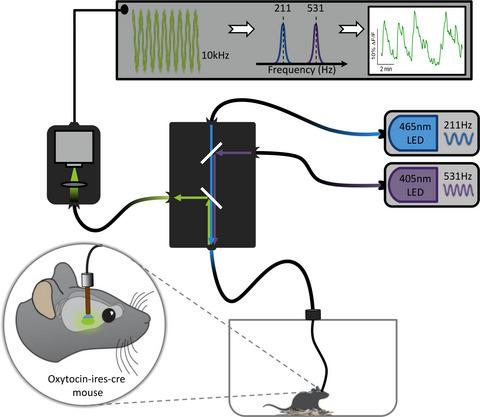当前位置:
X-MOL 学术
›
J. Neuroendocrinol.
›
论文详情
Our official English website, www.x-mol.net, welcomes your
feedback! (Note: you will need to create a separate account there.)
Visualising oxytocin neurone activity in vivo: The key to unlocking central regulation of parturition and lactation
Journal of Neuroendocrinology ( IF 3.3 ) Pub Date : 2021-07-21 , DOI: 10.1111/jne.13012 Michael R Perkinson 1 , Joon S Kim 1 , Karl J Iremonger 1 , Colin H Brown 1
Journal of Neuroendocrinology ( IF 3.3 ) Pub Date : 2021-07-21 , DOI: 10.1111/jne.13012 Michael R Perkinson 1 , Joon S Kim 1 , Karl J Iremonger 1 , Colin H Brown 1
Affiliation

|
During parturition and lactation, oxytocin neurones in the supraoptic and paraventricular nuclei fire high-frequency bursts of action potentials that are coordinated across the entire population. Each burst generates a large pulse of oxytocin release into the circulation to induce uterine contraction for parturition and mammary duct contraction for milk ejection. Bursts are stimulated by cervical stretch during parturition and by suckling during lactation. However, the mechanisms by which these stimuli are translated into episodic bursts are poorly understood, as are the mechanisms that coordinate bursts across the oxytocin neurone population. An elegant series of experiments conducted in the 1980s and 1990s used serial paired recordings to show that oxytocin neurones do not act as a syncytium during bursts; rather, they start each burst within a few hundred milliseconds of each other but with no distinct “leaders” or “followers”. In addition to afferent noradrenergic inputs that relay the systemic stimuli to oxytocin neurones, bursts depend on somato-dendritic oxytocin release within the hypothalamus. Hence, bursts are considered to be an emergent property of oxytocin neurones that is bootstrapped by appropriate afferent stimulation. Although much progress was made using traditional electrophysiological recordings in head-fixed anaesthetised animals, research has effectively stalled in the last few decades. However, the emergence of new technologies to monitor neuronal activity in freely-behaving animals has reinvigorated efforts to understand the biology underpinning burst firing in oxytocin neurones. Here, we report the use of fibre photometry to monitor the dynamics of milk ejection bursts in the oxytocin neurone population of freely-behaving mice. This approach will shed light on the neural mechanisms that control the oxytocin bursts underpinning parturition and lactation.
中文翻译:

可视化体内催产素神经元活动:解锁分娩和哺乳中枢调节的关键
在分娩和哺乳期间,视上核和室旁核中的催产素神经元会激发整个人群协调的动作电位的高频爆发。每次爆发都会产生大量的催产素脉冲释放到循环中,以诱导分娩时的子宫收缩和排出乳汁的乳腺导管收缩。分娩时的宫颈拉伸和哺乳期的哺乳会刺激爆发。然而,人们对这些刺激转化为间歇性爆发的机制知之甚少,协调整个催产素神经元群体爆发的机制也是如此。在 1980 年代和 1990 年代进行的一系列优雅的实验使用连续配对记录来表明催产素神经元在爆发期间不充当合胞体。相当,他们在几百毫秒内开始每次爆发,但没有明显的“领导者”或“追随者”。除了将全身刺激传递给催产素神经元的传入去甲肾上腺素能输入外,爆发还取决于下丘脑内的躯体树突催产素释放。因此,爆发被认为是催产素神经元的一种涌现特性,由适当的传入刺激引导。尽管在头部固定的麻醉动物中使用传统的电生理记录取得了很大进展,但在过去的几十年中,研究实际上已经停滞不前。然而,监测自由行为动物神经元活动的新技术的出现,重新激发了人们努力理解催产素神经元爆发性放电的生物学基础。这里,我们报告了使用纤维光度法来监测自由行为小鼠的催产素神经元群中喷乳爆发的动态。这种方法将阐明控制催产素爆发支持分娩和哺乳的神经机制。
更新日期:2021-07-21
中文翻译:

可视化体内催产素神经元活动:解锁分娩和哺乳中枢调节的关键
在分娩和哺乳期间,视上核和室旁核中的催产素神经元会激发整个人群协调的动作电位的高频爆发。每次爆发都会产生大量的催产素脉冲释放到循环中,以诱导分娩时的子宫收缩和排出乳汁的乳腺导管收缩。分娩时的宫颈拉伸和哺乳期的哺乳会刺激爆发。然而,人们对这些刺激转化为间歇性爆发的机制知之甚少,协调整个催产素神经元群体爆发的机制也是如此。在 1980 年代和 1990 年代进行的一系列优雅的实验使用连续配对记录来表明催产素神经元在爆发期间不充当合胞体。相当,他们在几百毫秒内开始每次爆发,但没有明显的“领导者”或“追随者”。除了将全身刺激传递给催产素神经元的传入去甲肾上腺素能输入外,爆发还取决于下丘脑内的躯体树突催产素释放。因此,爆发被认为是催产素神经元的一种涌现特性,由适当的传入刺激引导。尽管在头部固定的麻醉动物中使用传统的电生理记录取得了很大进展,但在过去的几十年中,研究实际上已经停滞不前。然而,监测自由行为动物神经元活动的新技术的出现,重新激发了人们努力理解催产素神经元爆发性放电的生物学基础。这里,我们报告了使用纤维光度法来监测自由行为小鼠的催产素神经元群中喷乳爆发的动态。这种方法将阐明控制催产素爆发支持分娩和哺乳的神经机制。











































 京公网安备 11010802027423号
京公网安备 11010802027423号